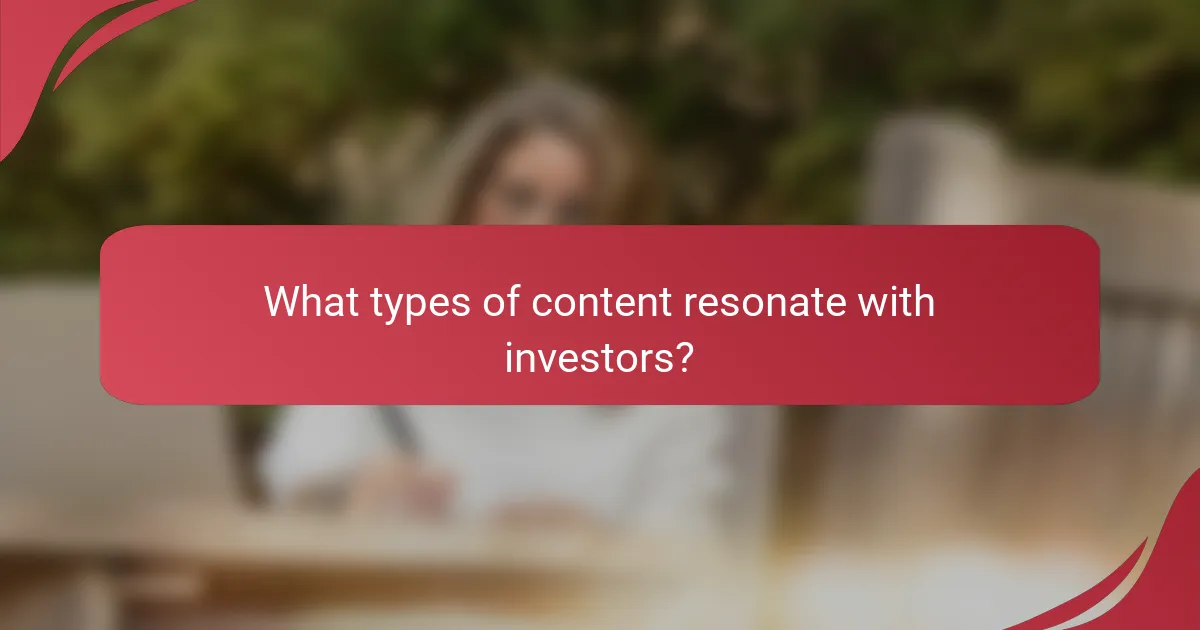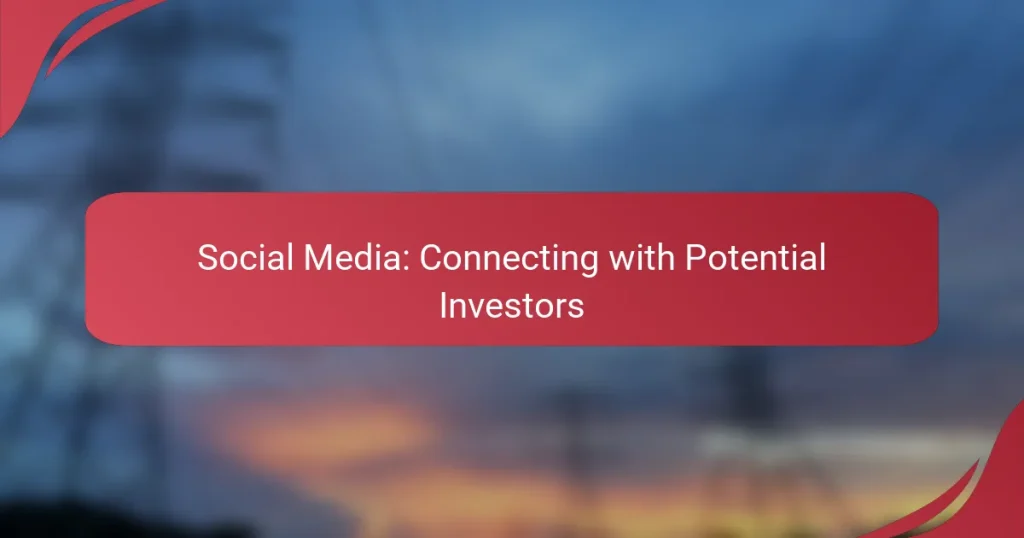Social media serves as a powerful tool for attracting potential investors by enabling targeted outreach and fostering meaningful connections. Platforms like LinkedIn, Instagram, and Twitter allow businesses to effectively showcase their value propositions and engage with interested parties through compelling content and networking opportunities.

How can social media attract potential investors?
Social media can attract potential investors by providing targeted outreach, engaging content, and networking opportunities. By leveraging platforms like LinkedIn, Instagram, and Twitter, businesses can effectively showcase their value propositions and connect with interested parties.
Targeted advertising on platforms like LinkedIn
LinkedIn offers robust advertising options that allow businesses to target specific demographics, industries, and job titles. This precision helps ensure that your message reaches potential investors who are most likely to be interested in your offerings.
Consider using sponsored content or InMail campaigns to directly engage with potential investors. Setting a budget that aligns with your goals, such as a few hundred to several thousand dollars, can help maximize your visibility and impact.
Engaging content strategies on Instagram
Instagram is ideal for visually showcasing your brand and its achievements. High-quality images, infographics, and short videos can effectively communicate your business story and attract investor interest.
Utilize features like Stories and Reels to create engaging content that highlights milestones, product launches, or behind-the-scenes looks at your operations. Regularly posting and interacting with followers can build a community that may include potential investors.
Networking through Twitter chats
Twitter chats provide a platform for real-time discussions on industry topics, allowing you to connect with potential investors and influencers. Participating in relevant chats can increase your visibility and establish your authority in your field.
To maximize your networking efforts, prepare thoughtful questions or insights to share during chats. Engaging consistently can help you build relationships that may lead to investment opportunities in the future.

Which social media platforms are best for investor outreach?
LinkedIn, Twitter, and Facebook are among the most effective social media platforms for connecting with potential investors. Each platform offers unique advantages that can enhance your outreach strategy.
LinkedIn for professional connections
LinkedIn is the premier platform for professional networking, making it ideal for investor outreach. It allows you to showcase your business profile, share updates, and connect with industry professionals, including potential investors.
To maximize your presence, ensure your profile is complete and highlights your achievements. Engage with relevant content and join industry-specific groups to increase visibility among investors.
Twitter for real-time engagement
Twitter excels in facilitating real-time engagement and discussions. It allows you to share quick updates, industry news, and insights, which can attract the attention of investors looking for timely information.
Use hashtags strategically to reach a broader audience and participate in relevant conversations. Regularly interact with followers and industry leaders to build relationships that could lead to investment opportunities.
Facebook for community building
Facebook is effective for building a community around your brand and engaging with potential investors on a personal level. You can create a business page to share updates, host events, and foster discussions that resonate with your audience.
Consider using Facebook Groups to create a dedicated space for discussions related to your industry. This can help establish trust and loyalty, making it easier to connect with investors who share your vision.

What types of content resonate with investors?
Investors are most engaged by content that clearly demonstrates potential for growth and success. This includes real-life examples, data-driven insights, and compelling narratives that highlight a business’s value proposition.
Case studies showcasing success
Case studies that illustrate successful outcomes can significantly attract investor interest. They provide tangible evidence of a business’s ability to execute its strategy and achieve results. Highlight key metrics such as revenue growth, customer acquisition, and market expansion to make a strong case.
When presenting a case study, focus on the problem faced, the solution implemented, and the measurable results achieved. Use clear visuals and concise narratives to enhance understanding and retention.
Infographics with market insights
Infographics are effective tools for conveying complex market insights in a digestible format. They can summarize trends, competitive landscapes, and consumer behavior, making it easier for investors to grasp critical information quickly.
Ensure your infographics are visually appealing and data-rich. Use colors and icons to highlight key statistics and trends, and always cite your sources to establish credibility.
Video pitches highlighting value propositions
Video pitches are powerful for showcasing a business’s value proposition in a dynamic way. They allow entrepreneurs to convey passion and personality while clearly outlining what sets their offering apart from competitors.
Keep video pitches concise, ideally under three minutes, and focus on the problem, solution, and potential return on investment. Include testimonials or endorsements to build trust and credibility with potential investors.

How to measure social media effectiveness for investor engagement?
Measuring social media effectiveness for investor engagement involves analyzing various metrics that reflect how well your online presence attracts and interacts with potential investors. Key indicators include engagement rates, conversion rates, and the use of analytics tools to track performance over time.
Analytics tools like Hootsuite
Analytics tools such as Hootsuite provide comprehensive insights into your social media performance. These platforms allow you to monitor engagement metrics, track follower growth, and analyze post performance across different channels. By utilizing these tools, you can identify which content resonates with potential investors and adjust your strategy accordingly.
Consider setting up dashboards to visualize key metrics, making it easier to spot trends and opportunities. Regularly reviewing these analytics can help you refine your messaging and outreach efforts to better connect with your target audience.
Engagement metrics tracking
Tracking engagement metrics is crucial for understanding how your audience interacts with your content. Key metrics include likes, shares, comments, and click-through rates. High engagement levels often indicate that your content is relevant and appealing to potential investors.
To effectively track these metrics, establish benchmarks based on your past performance or industry standards. Aim for consistent engagement growth, and be prepared to experiment with different content types to see what drives the most interaction.
Conversion rate analysis
Conversion rate analysis helps you determine how effectively your social media efforts translate into actionable outcomes, such as inquiries or investments. A good conversion rate indicates that your messaging is compelling and that your audience is motivated to take the next step.
To analyze conversion rates, set clear goals for what constitutes a conversion, such as signing up for a newsletter or requesting a meeting. Use tracking links to monitor these actions and regularly assess your conversion data to identify areas for improvement. Aim for incremental increases in your conversion rates by refining your calls to action and targeting strategies.

What are the prerequisites for a successful social media strategy?
A successful social media strategy requires clear branding, a defined target audience, and a consistent posting schedule. These elements work together to create a cohesive online presence that attracts potential investors and fosters engagement.
Clear branding and messaging
Clear branding and messaging are essential for establishing a recognizable identity on social media. This includes a consistent logo, color scheme, and tone of voice that reflects your business values. Ensure that your messaging resonates with your target audience and communicates your unique selling propositions effectively.
For example, a tech startup might use modern graphics and a casual tone to appeal to younger investors, while a financial firm may opt for a more professional look and formal language. Regularly review your branding to maintain alignment with your business goals and audience expectations.
Defined target audience
Identifying your defined target audience is crucial for tailoring your social media strategy. Understand who your potential investors are, including their demographics, interests, and online behaviors. This information helps you create content that speaks directly to their needs and preferences.
Utilize tools like surveys or social media analytics to gather insights about your audience. Segment your audience based on factors such as age, location, and investment interests to deliver more personalized content that increases engagement and conversion rates.
Consistent posting schedule
A consistent posting schedule is vital for maintaining visibility and engagement on social media. Aim to post regularly, whether it’s daily, a few times a week, or weekly, depending on your audience’s preferences and platform norms. This consistency helps keep your brand top-of-mind for potential investors.
Consider using a content calendar to plan and organize your posts in advance. This approach allows you to maintain a steady flow of content while ensuring variety in topics and formats. Avoid long gaps between posts, as this can lead to decreased engagement and interest from your audience.

How to build a community around your brand on social media?
Building a community around your brand on social media involves engaging your audience through meaningful interactions and content. Focus on creating a space where followers feel valued and connected to your brand’s mission.
Creating interactive polls and Q&A sessions
Interactive polls and Q&A sessions are effective tools for fostering community engagement. They allow your audience to express their opinions and ask questions directly, making them feel involved in the brand’s journey.
To implement polls, use platforms like Instagram Stories or Twitter, where you can easily create quick surveys. For Q&A sessions, consider hosting live events on Facebook or Instagram, encouraging followers to submit questions in real-time.
When planning these activities, keep your audience’s interests in mind. Aim for topics that resonate with them and encourage participation. Avoid overly complex questions; instead, focus on straightforward, engaging content that invites responses.


